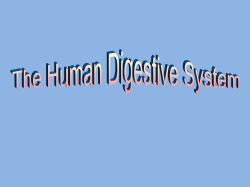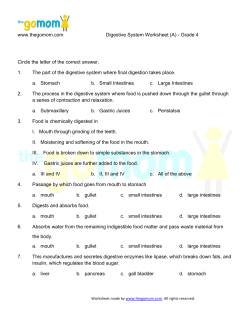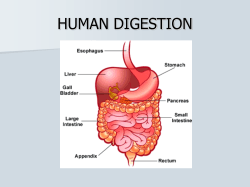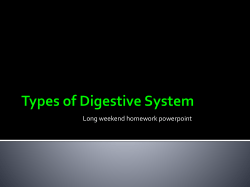
Human Digestion
Human Digestion Nutrition Process by which organisms obtain and utilize their food. There are two parts to Nutrition: 1. Ingestion- process of taking food into the digestive system so that it may be hydrolized or digested. 2. Digestion- the breakdown of food (either chemically or mechanically) in order to utilize nutrients Types of Nutrients • Micronutrients- vitamins, minerals, & water • Macronutrients- proteins, lipids, carbohydrates, etc… Human digestive system GI (gastrointestinal) tract = alimentary canal Ingestion • Mouth – mechanical digestion • teeth – breaking up food – chemical digestion • saliva – amylase » enzyme digests starch – mucin » slippery protein (mucus) » protects soft lining of digestive system » lubricates food for easier swallowing – buffers » neutralizes acid to prevent tooth decay – anti-bacterial chemicals » kill bacteria that enter mouth with food mouth break up food digest starch kill germs moisten food Mouth • Chemical and mechanical digestion. • Food is chewed (masticated) mechanically. • A bolus (lump) is formed with saliva and the tongue. Swallowing (& not choking) • Epiglottis – flap of cartilage – closes trachea (windpipe) when swallowing – food travels down esophagus • Peristalsis – involuntary muscle contractions to move food along Which type of digestion is the following? 1. Chewing a saltine? 2. Saliva breaking the saltine down into molecules of glucose? 3. Your tongue breaking pieces of a hamburger apart? 4. Pepsin (an enzyme) in your stomach breaking the hamburger into amino acids? Pharynx • The back of the throat. • Larynxpassage for air, closes when we swallow. • Is approximately 15cm long. Digestive Glands • Groups of specialized secretory cells. • Found in the lining of the alimentary canal or accessory organs. Peristalsis • series of involuntary wave-like muscle contractions which move food along the digestive tract Stomach • Food is temporarily stored here. • Gastric juices are secreted. • Has layers of muscle that line the inside. • Mechanically and chemically breaks down food. Stomach • Functions – food storage • can stretch to fit ~2L food – disinfect food • HCl = pH 2 – kills bacteria – chemical digestion • pepsin – enzyme breaks down proteins But the stomach is made out of protein! What stops the stomach from digesting itself? mucus secreted by stomach cells protects stomach lining mouth break up food digest starch kill germs moisten food stomach kills germs break up food digest proteins store food sphincter sphincter Gastric Juices • Secreted by the stomach. • Acidic (pH 1.5-2.5) (HCl). • Pepsin- an enzyme that breaks down large proteins into amino acids. • Food is further broken down into a thin liquid called chyme. Accessory Organs • Pancreas • Gall Bladder • Spleen Gall bladder • Pouch structure located near the liver which concentrates and stores bile • Bile duct – a long tube that carries BILE. The top half of the common bile duct is associated with the liver, while the bottom half of the common bile duct is associated with the pancreas, through which it passes on its way to the intestine. BILE • Bile emulsifies lipids (physically breaks apart FATS) • Bile is a bitter, greenish-yellow alkaline fluid, stored in the gallbladder between meals and upon eating is discharged into the duodenum where it aids the process of digestion. Pancreas • An organ which secretes both digestive enzymes (exocrine) and hormones (endocrine) • ** Pancreatic juice digests all major nutrient types. • Nearly all digestion occurs in the small intestine & all digestion is completed in the SI. Pancreas • Digestive enzymes – digest proteins • trypsin, chymotrypsin – digest starch • amylase • Buffers – neutralizes acid from stomach Liver • Function – produces bile • bile stored in gallbladder until needed • breaks up fats – act like detergents to breakup fats bile contains colors from old red blood cells collected in liver = iron in RBC rusts & makes feces brown mouth break up food digest starch kill germs moisten food liver produces bile - stored in gall bladder break up fats pancreas produces enzymes to digest proteins & starch stomach kills germs break up food digest proteins store food Small Intestine • Most chemical digestion takes place here. • Simple sugars and proteins are absorbed into the inner lining. • Fatty acids and glycerol go to lymphatic system. • Lined with villi, which increase surface area for absorption, one cell thick. Small intestine • Function – chemical digestion • major organ of digestion & absorption – absorption through lining • over 6 meters! • small intestine has huge surface area = 300m2 (~size of tennis court) • Structure – 3 sections • duodenum = most digestion • jejunum = absorption of nutrients & water • ileum = absorption of nutrients & water Duodenum • 1st section of small intestines – acid food from stomach – mixes with digestive juices from: pancreas liver gall bladder mouth break up food digest starch kill germs moisten food pancreas produces enzymes to digest proteins & starch stomach kills germs break up food digest proteins store food Absorption in the SI • Much absorption is thought to occur directly through the wall without the need for special adaptations • Almost 90% of our daily fluid intake is absorbed in the small intestine. • Villi - increase the surface area of the small intestines, thus providing better absorption of materials Absorption by Small Intestines • Absorption through villi & microvilli – finger-like projections – increase surface area for absorption VILLI Large intestines (colon) • Function – re-absorb water • use ~9 liters of water every day in digestive juices • > 90% of water reabsorbed – not enough water absorbed » diarrhea – too much water absorbed » constipation Large Intestine • Solid materials pass through the large intestine. • These are undigestible solids (fibers). • Water is absorbed. • Vitamins K and B are reabsorbed with the water. • Rectum- solid wastes exit the body. You’ve got company! • Living in the large intestine is a community of helpful bacteria – Escherichia coli (E. coli) • produce vitamins – vitamin K; B vitamins • generate gases – by-product of bacterial metabolism – methane, hydrogen sulfide Vestigial organ Appendix Rectum • Last section of colon (large intestines) – eliminate feces • undigested materials – extracellular waste » mainly cellulose from plants » roughage or fiber – masses of bacteria Digestive Homeostasis Disorders • ULCERS – erosion of the surface of the alimentary canal generally associated with some kind of irritant Digestive Homeostasis Disorders • CONSTIPATION – a condition in which the large intestine is emptied with difficulty. • Too much water is reabsorbed • and the solid waste hardens Digestive Homeostasis Disorders • DIARRHEA – a gastrointestinal disturbance characterized by decreased water absorption and increased peristaltic activity of the large intestine. • This results in increased, multiple, watery feces. • This condition may result in severe dehydration, especially in infants Digestive Homeostasis Disorders • APPENDICITIS – an inflammation of the appendix due to infection • Common treatment is removal of the appendix via surgery Digestive Homeostasis Disorders • GALLSTONES – an accumulation of hardened cholesterol and/or calcium deposits in the gallbladder • Can either be “passed” (OUCH!!) or surgically removed Digestive Homeostasis Disorders • • • ANOREXIA NERVOSA - a psychological condition where an individual thinks they appear overweight and refuses to eat. Weighs 85% or less than what is developmentally expected for age and height Young girls do not begin to menstruate at the appropriate age. Digestive Homeostasis Disorders • HEART BURN – ACID from the stomach backs up into the esophagus. Let’s go to the Video! QuickTime™ and a decompressor are needed to see this picture. Digestive System Cadaver QuickTime™ and a decompressor are needed to see this picture. Travel Through the Digestive System QuickTime™ and a decompressor are needed to see this picture.
© Copyright 2025





















